511
Views & Citations10
Likes & Shares
Guinea Bissau stood out not only having ITN ownership in over 90%of households but also having aided both extreme poor and wealthy areas, progress in ownership of ITN at similar levels. Thus, a deeper study of their interventions compared to other countries to identify factors that facilitated high ITN ownership not skewed to one wealth area, is required. Then the policies and activities would have to be recommended to other countries to replicate results in other countries.
Keywords: Insecticide Treated Nets (ITN), Wealth, Africa
Abbreviations: ITN: Insecticide Treated Nets; MICS: Multiple Indicator Cluster Survey; LLINS: Long-Lasting Insecticide-Treated Nets; BHD: Bamenda Health District
Across 29 countries in sub-Saharan Africa between 2011 and 2016 the median (range) of the percentage of households with enough ITNs was 30.7% (8.5-62.0%). The use of ITN was observed to increase at ages 0-4 years and 30-40 years. It concluded that having sufficient ITNs in the household increases rate of utilization and reduces existing disparities between age and gender groups [3].
ITNs were 14.5% in Central; 38.4% in East Africa; and, 30.7% in West Africa. In only 3 countries did more than 50% of households own enough ITNs: Uganda (62.0%), Senegal (56.7%) and Ghana (50.3%) [3].
Despite the advantages of using ITNs in the prevention of Malaria it is known that some households/individuals don’t use it, Koenker [4] using a total of 156 surveys from 2003-2023 researched the reasons why nets were not used the previous nights. Reasons for non-use of nets varied by household net supply, and in some surveys by residence. Unused nets were firstly those being saved for later use, or were not used due to perceived low risk of malaria.
In Senegal, the rate of nets used increased during high transmission season, and reduced during the dry season, due to a reduction in mosquitoes [4].
Despite ITN ownership in the highland regions of western Kenya reaching more than 71%, usage compliance was low at 56.3%. The usage was reported to be 62% during the rainy season compared with 49.6% dry season. Malaria prevalence was reported in this study to be 30% lower in ITN users than in non-ITN users [5].
The 2018 Guinea survey study results show that 44% of households owned ITNs, 31% of individuals had access to ITNs out of which 66.1% used them. In Guinea, household size, marital status of the household head, education level of the household head, and region were risk factors for household ITN ownership [6].
The high ownership of ITN without correlated level of usage was also observed in Sunyani West district of Ghana even after launching a free mass insecticide-treated net (ITN) distribution campaign in the year 2015. A research reported the level of ownership and usage of ITNs and associated factors among households in the Sunyani West district two years after the mass distribution campaign. ITN ownership was observed to be 78.93% but usage was 55.93% [7].
A 2022 study described factors associated with consistent ITN factors use in Cameroon, Côte d’Ivoire and Sierra Leone inclusive of sociodemographic, psychosocial, and household factors (8). While these factors varied across countries, all 3 countries had over 65% consistency in ITN use [8].
Over three million long-lasting insecticide-treated nets (LLINs) were distributed in 2010, at Sierra Leone. It was aimed at providing protection from malaria to individuals in all households in the country. In households owning ≥1 ITN, 76.5% slept under an ITN the night preceding the survey [9].
A Cameroonian study observed despite the interventions to scale up ITN distribution to attain universal coverage, coverage remains low [10]. Heat was reported to be the most common barrier to the consistent use of ITN in a Ghanaian study [11] other barriers included skin irritation, lack of information, lack of airflow, and gender differences, men are more likely to sleep outdoors than women [11].
METHOD
Study Design and Data source
Data was obtained from UNICEF database for insecticide treated net ownership by households. The Percentage of households with at least one insecticide treated mosquito net (ITN) database was obtained.
Variables of Interest
The UNICEF reporting region selected was West and Central African Countries, the world bank income group selected were low income and lower middle-income groups. The survey source selected was Multiple Indicator Cluster Survey (MICS), the parameters selected for comparison were based on wealth demographic.
Years 2006 and 2010 was selected because most countries had data within these years for the selected survey and ITN ownership between these countries could compare to detect areas of lower concentration. Then countries with data for more than one year were selected to compare ownership rate within the same country between or across years.
Data presentation was done using Excel.
RESULTS
As observed in the figure below (Figure 1) Cameroon had the lowest percentage of households with a minimum of one ITN in 2006 across wealth variables. Same year Gambia had the highest household owning ITN at a level of over 60% but this was majorly in the rural and poor areas. All other countries had less than 55% households with a minimum of one ITN. Though at a lower level Guinea Bissau showed more households with ITN in the rural/poorest than rich/urban areas.
In 2006, 20% higher households with at least one ITN in Burkinafaso was observed in rich/urban than rural/poorest areas, Sao Tome and Principe and Central African Republic had similar results but at a lower level.
In 2010, 8 countries showed results within the survey analyzed, amongst which Mali had the highest households with ITN irrespective of wealth variable. Apart from Mali all other countries ranged between 26%-68%. Gambia showed above 10% higher households with ITN in rural/poorest than urban/rich areas. Chad had the opposite with higher in rich/urban than poorest/rural areas. Some countries inclusive of Sierra Leone and Central African Republic showed little variation with wealth difference (Figure 2).
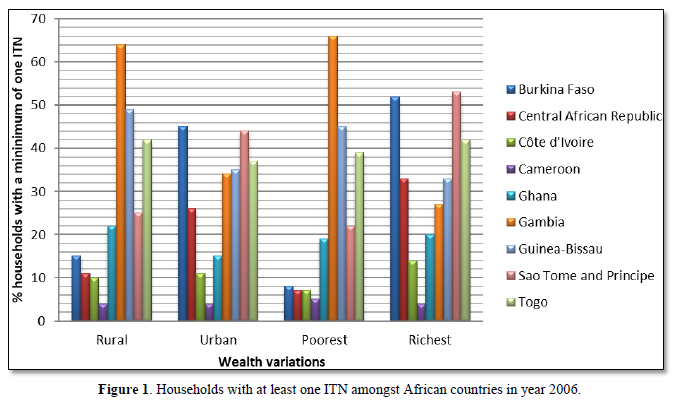
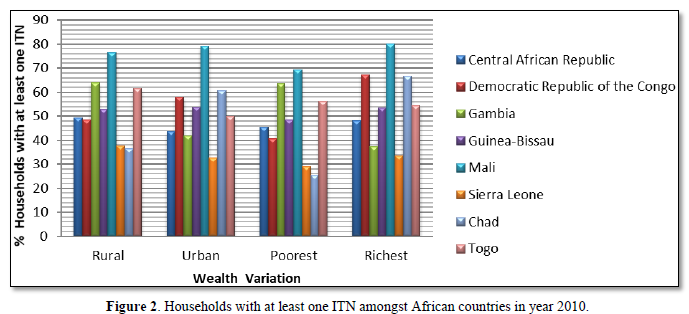
Central African Republic peaked in the year 2019 to about 70% in the rich /urban zones compared to other years. Though in 2006 less than 15% households had at least one ITN in the poorest/rural areas (Figure 3), over 30% increase was observed as the year progressed. Though increase in households with ITN with year progression was more in urban/ rich zones of the country.
As can be observed in Figures 2-10 most individual countries analyzed had increase in the percentage of households with ITN with progress in years though a few showed reverse in some wealth zones/years.
Gambia, Ghana, Mauitana, Sierra Leone and Togo poorest/rural areas had higher ITN compared to urban/ rich areas. The reverse was the case with Central African Republic, and Sao Tome and Principe.
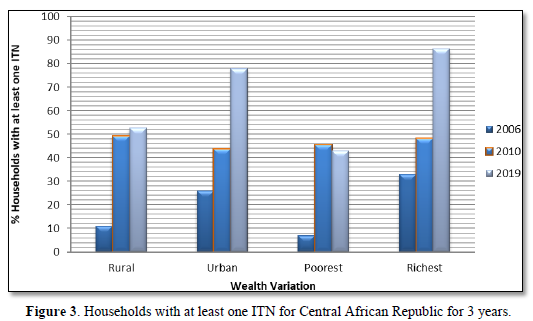
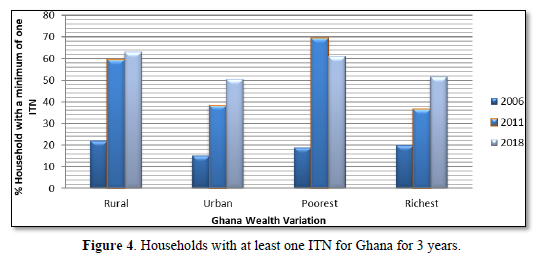
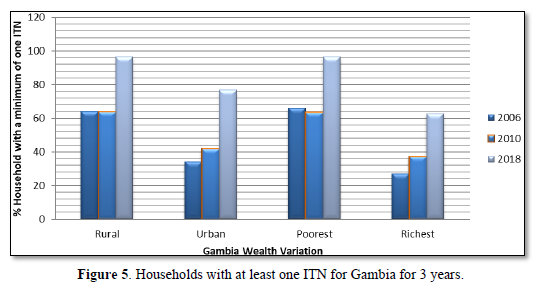
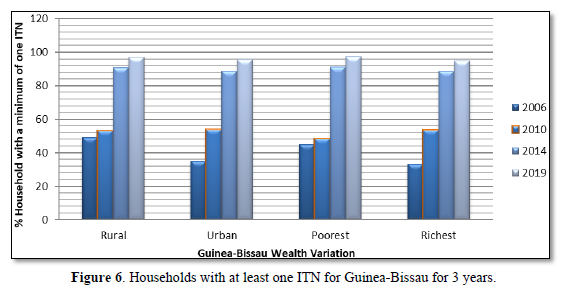
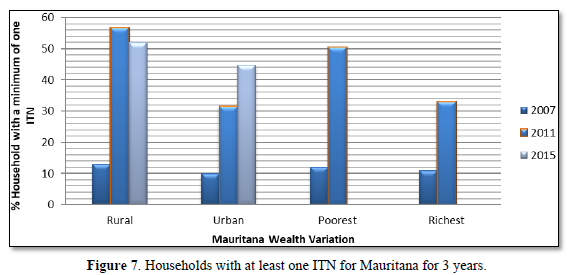
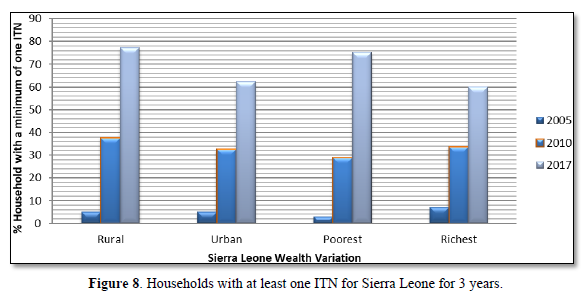
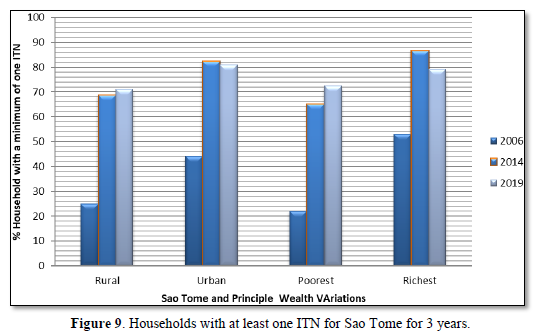
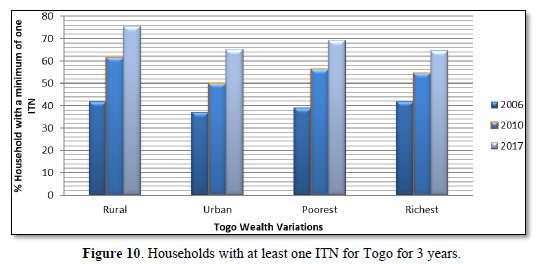
DISCUSSION
Guinea Bissau also had the highest percentage of households with at least one ITN in the most recent years almost at a100% irrespective of wealth variation, depicting that at present whether poor or rich, living in rural or urban zones almost every household own at least one ITN in Guinea Bissau. In line with this study, a 2020 study reported that every household in Guinea Bissau contained nets [12]. Though the usage rates and state of the long-lasting insecticide-treated net (LLIN), was beyond the scope of this present study. Hutchins et al 2020, reported that 23.0% of households had a minimum of one expired net, 89.0% of households also reported that all residents used nets. The communities were also reported to have good knowledge of malaria; however, it was also stated the persistence of malaria despite the high ownerships of LLINs observed in their research suggests the importance of novel supplementary approaches [12].
Conversely, of the 9 Countries with MIC survey data set for year 2006 Cameroon had the lowest percentage of households with a minimum of one ITN in 2006 across wealth variables in this study. Though it was observed in Bamenda Health District (BHD) of Cameroon that the frequency of bednet ownership was as high as 63.5%, though still below the WHO recommendation of bednet ownership. The disparity in this report and the present study could be that the result obtained at BHD is not representative of the whole country. It is also worthy to note that 87.7% of households in the BHD study obtained their bednets during the 2011 free distribution campaign. The low ITN reported in our study was observed in 2006 survey which was half a decade before the distribution, thus a possible improvement could have occurred post the 2006 survey. Unfortunately, Cameroon was not one of the individual countries analyzed to observe the ITN ownership with increase in years [13].
The results obtained in our study for Cameroon was however similar to an earlier publication which stated that despite the interventions to scale up ITN distribution to attain universal coverage, coverage remains low in Cameroon [10].
Our study showed that majority of the countries in 2006 had less than 50% households with ITN though still low, the number of countries were a bit improved in 2010 this is in line with a 2018 publication that stated that only 3 countries had over 50% of households owning enough ITNs: Uganda (62.0%), Senegal (56.7%) and Ghana (50.3%) [3].
One major positive highlight in this study is that most of the individual countries were observed to have increased households with ITN ownership as the years progressed. It is however been observed in past literature that ownership does not correlate always to the level of usage, as was earlier stated in Kenya, Guinea and Sunyani West district of Ghana where usage was lower than ownership level (5, 6, 7). Thus, though this study shows that ITN ownership tends to increase with time effort has to be made so usage also increase.
Out of the eight Individual African countries analyzed in our study 5 showed poorest/rural areas had higher ITN compared to urban/ rich zones. This could be due to interventions directed majorly to low income areas.
Guinea Bissau stood out having aided both extreme poor and wealthy areas, progress in ownership of ITN at similar levels. Further study as to their interventions compared to other countries which gave a high improvement of ITN not skewed to one wealth area, is important. Then the policies and activities would have to be recommended to other countries to replicate results in other countries.
- WHO (2024) World malaria report 2024. Available online at: https://www.who.int/teams/global-malaria-programme/reports/world-malaria-report-2024
- Ameyaw EK (2021) Individual, community and societal correlates of insecticide treated net use among pregnant women in sub-Saharan Africa: A multi-level analysis. BMC Public Health 21(1): 1592.
- Olapeju B, Choiriyyah I, Lynch M, Acosta A, Blaufuss S, et al. (2018) Age and gender trends in insecticide-treated net use in sub-Saharan Africa: A multi-country analysis. Malaria J 17(1): 423.
- Koenker H, Kumoji EK, Erskine M, Opoku R, Sternberg E, et al. (2023) Reported reasons for non-use of insecticide-treated nets in large national household surveys, 2009-2021. Malaria J 22 (1): 61.
- Atieli HE, Zhou G, Afrane Y, Lee MC, Mwanzo I, et al (2011) Insecticide-treated net (ITN) ownership, usage, and malaria transmission in the highlands of western Kenya. Parasit Vectors 4(1): 113.
- Diallo OO, Ozodiegwu ID, Camara A, Galatas B, Gerardin J (2023) Factors associated with the ownership and use of insecticide-treated nets in Guinea: An analysis of the 2018 Demographic and Health Survey. Malaria J 22(1): 29.
- Mensah EA, Anto F (2020) Individual and Community Factors Associated with Household Insecticide‐Treated Bednet Usage in the Sunyani West District of Ghana Two Years after Mass Distribution. J Environ Public Health 2020(1): 7054383.
- Babalola S, Kumoji K, Awantang GN, Oyenubi OA, Toso M, et al. (2022) Ideational factors associated with consistent use of insecticide-treated nets: A multi-country, multilevel analysis. Malaria J 21(1): 374.
- Bennett A, Smith SJ, Yambasu S, Jambai A, Alemu W, et al. (2012) Household possession and use of insecticide-treated mosquito nets in Sierra Leone 6 months after a national mass-distribution campaign. PLoS One 7(5): e37927.
- Njumkeng C, Apinjoh TO, Anchang-Kimbi JK, Amin ET, Tanue EA, et al. (2019) Coverage and usage of insecticide treated nets (ITNs) within households: associated factors and effect on the prevalence of malaria parasitemia in the Mount Cameroon area. BMC Public Health 19(1): 1216.
- Ahorlu CS, Adongo P, Koenker H, Zigirumugabe S, Sika-Bright S, et al. (2019) Understanding the gap between access and use: A qualitative study on barriers and facilitators to insecticide-treated net use in Ghana. Malaria J 18(1): 417.
- Hutchins H, Power G, Ant T, Teixeira da Silva E, Goncalves A, et al. (2020) A survey of knowledge, attitudes and practices regarding malaria and bed nets on Bubaque Island, Guinea-Bissau. Malaria J 19(1): 412.
- Fokam EB, Kindzeka GF, Ngimuh L, Dzi KT, Wanji S (2017) Determination of the predictive factors of long-lasting insecticide-treated net ownership and utilization in the Bamenda Health District of Cameroon. BMC Public Health 17(1): 263.
QUICK LINKS
- SUBMIT MANUSCRIPT
- RECOMMEND THE JOURNAL
-
SUBSCRIBE FOR ALERTS
RELATED JOURNALS
- Journal of Carcinogenesis and Mutagenesis Research (ISSN: 2643-0541)
- Journal of Rheumatology Research (ISSN:2641-6999)
- Journal of Infectious Diseases and Research (ISSN: 2688-6537)
- Journal of Otolaryngology and Neurotology Research(ISSN:2641-6956)
- Advance Research on Alzheimers and Parkinsons Disease
- Journal of Psychiatry and Psychology Research (ISSN:2640-6136)
- Advance Research on Endocrinology and Metabolism (ISSN: 2689-8209)












